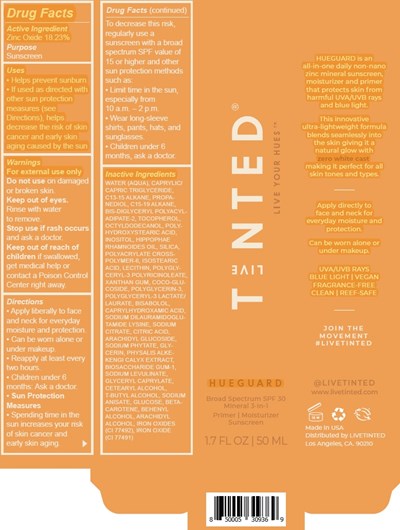Product Images Live Tinted Hueguard 3-in1 Mineral Sunscreen Moisturizer Primer Broad Spectrum Spf 30
View Photos of Packaging, Labels & Appearance
Product Label Images
The following 2 images provide visual information about the product associated with Live Tinted Hueguard 3-in1 Mineral Sunscreen Moisturizer Primer Broad Spectrum Spf 30 NDC 82153-001 by Live Tinted, Inc., such as packaging, labeling, and the appearance of the drug itself. This resource could be helpful for medical professionals, pharmacists, and patients seeking to verify medication information and ensure they have the correct product.
Inner Package - Inner Package

HUEGUARD is a daily sunscreen that contains non-nano zinc and is also a moisturizer and primer. It protects the skin from harmful UVA/UVB rays and blue light. The product has an ultra-lightweight formula that blends seamlessly into the skin giving it a natural glow, making it suitable for all skin tones and types. It can be applied directly to the face and neck for everyday moisture and protection and can be worn alone or under makeup. The product is fragrance-free and vegan. The active ingredient in the product is 18-23% Zinc Oxide. The product has warning information for external use only. The product is made in the USA and distributed by LIVETINTED in Los Angeles, California.*
Outer Package - Outer Package

This is a skincare product called HUEGUARD which is a daily non-nano zinc mineral sunscreen, moisturizer, and primer with an SPF value of 15 or higher. It protects skin from harmful UVA/UVB rays, blue light, and has an innovative lightweight formula. It can blend seamlessly into skin of all tones and types and can be worn alone or under makeup. The product prevents sunburns and decreases the risk of skin cancer and early skin aging due to sun exposure. The details of usage, directions, and precautions for use are also given, and the product is distributed by LIVETINTED in Los Angeles.*
* The product label images have been analyzed using a combination of traditional computing and machine learning techniques. It should be noted that the descriptions provided may not be entirely accurate as they are experimental in nature. Use the information in this page at your own discretion and risk.